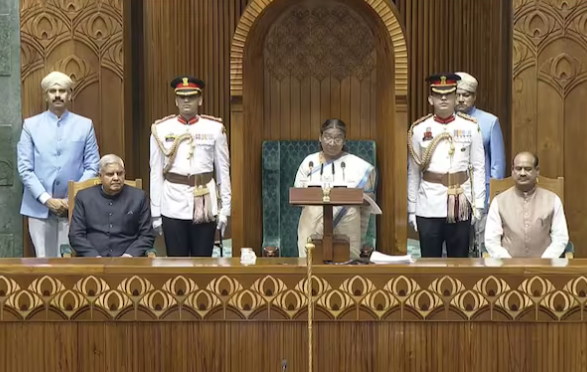Joint Sitting of Parliament and Leader of House (GS Paper 2, Polity)

Introduction:
- In the intricate framework of India's parliamentary democracy, certain mechanisms and roles hold significant importance in ensuring the smooth functioning and resolution of legislative processes.
- Among these are the joint sittings of Parliament and the position of the Leader of the House.
- Recently, the President of India addressed the joint sitting of both houses of Parliament, highlighting the relevance and procedural nuances of such events.
What is the Joint Sitting of Parliament?
About:
- A joint sitting involves both houses of Parliament, the Lok Sabha and the Rajya Sabha, meeting together to deliberate and make decisions on crucial legislative matters.
Types of Joint Sittings in the Constitution:
Presidential Address under Article 87:
- The President addresses both Houses of Parliament at the beginning of the first session after each general election and at the beginning of the first session of each year.
- The Constitution (First Amendment) Act of 1951 modified Article 87 to specify that the President addresses "the first session after each general election to the House of the People and at the commencement of the first session of each year."
Resolution of Legislative Deadlocks under Article 108:
- Joint sittings can be convened when a bill is passed by one house but rejected or not returned by the other, when the President returns a bill for reconsideration, or when more than six months have elapsed without the bill being passed by the other House.
Significance of Joint Sitting:
- Joint sittings serve as a crucial platform for resolving legislative impasses and facilitating comprehensive discussions on important national issues.
- They provide the President an opportunity to outline the government's policy priorities and legislative agenda, particularly after general elections, reflecting the mandate and priorities of the newly elected government.
Key Provisions for Joint Sittings:
- Chairmanship: The Speaker of the Lok Sabha chairs the joint sittings.
- Rules of Procedure: The proceedings follow the Lok Sabha's rules of procedure.
- Quorum: One tenth of the total members from both houses form the quorum.
- Purpose: Joint sittings are used as a last resort to resolve legislative deadlocks.
Exceptions to Joint Sittings:
- Money Bills (Article 110)
- Constitution Amendment Bills (Article 368)
Historical Context:
Since 1950, only three bills have been passed through joint sittings:
- Dowry Prohibition Bill, 1960
- Banking Service Commission (Repeal) Bill, 1977
- Prevention of Terrorism Bill, 2002
Who is the Leader of the House (LOH)?
Current LOH in Rajya Sabha:
- Health Minister Jagat Prakash Nadda was recently appointed as the Leader of the House in the Rajya Sabha.
Legal Backing:
- The term Leader of the House is defined in the Rules of Procedure for both the Lok Sabha and the Rajya Sabha.
Appointment Process:
- The LOH is a minister and a member of the Rajya Sabha, nominated by the Prime Minister.
- The Leader of the House can appoint a Deputy Leader of the House.
- In the United States, a comparable position is known as the 'majority leader.'
Responsibilities:
- Conducts the overall process, especially debates and discussions.
- Maintains harmony among members.
- Upholds the respect of the Rajya Sabha.
- Ensures standard proceedings during parliamentary debates.
LOH in Lok Sabha:
- Typically, the Prime Minister if they are a house member.
- If not, it's a Minister who is a member and is nominated by the Prime Minister for this role.
- By convention, the Prime Minister is always the Leader of the Lok Sabha.
Conclusion:
- The joint sittings of Parliament and the role of the Leader of the House are pivotal in maintaining the integrity and efficiency of the legislative process in India.
- They ensure that even in the face of political stalemates, there is a structured mechanism to move forward and address critical national issues.
- The recent presidential address to the joint sitting of the newly elected 18th Lok Sabha underscores the ongoing relevance of these parliamentary procedures in shaping the country's legislative agenda and governance.


